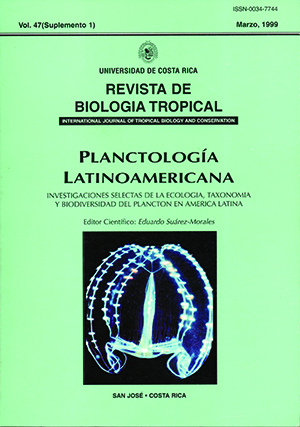Resumen
Se registraron las variaciones de parámetros físico-químicos y la structura de la communidad planctónica de varias lagunas de estabilización de aguas residuales urbanas en Nueva Delhi (India) desde los meses de verano hasta invierno de 1992-1993. Las variables físicas y químicas cuantificadas fueron temperatura, pH, oxígeno disuelto, fósforo reactivo soluble, fósforo total, nitrógeno como nitrato y clorofila-a. También se registró un análisis cualitativo del fitoplancton en todas las lagunas. Del zooplancton se identificó y cuantificó rotíferos, cladóceros y copépodos. Las observaciones se hicieron mensualmente. Las concentraciones de fósforo reactivo soluble, fósforo total y nitrógeno como nitrato oscilaron entre 1.2-2.0 mg l-1, 2.0-3.5 mg l-1 y 0.075- 0.30 mg l-1, respectivamente. Aunque no hubo diferencias significativas en las concentraciones de nutrientes entre los cuerpos de agua, las lagunas que recibían las aguas sin tratamiento tuvieron primero niveles indetectables de clorofila a la mayor parte de período del muestreo. En la medida que las aguas pasaban en la serie de lagunas, su calidad mejoró y finalmente, mantuvo altas densidades de zooplancton. Se observaron poblaciones masivas de Euglena, Pandorina, Spirulina y Oscillatoria. Las especies de rotíferos comúnmente encontradas fueron Brachionus calyciflorus, Hexarthra mira y Filinia longiseta. Los cladóceros y copépodos estuvieron representados, casi exclusivamente por Moina macrocopa y Mesocyclops thermocyclopoides, respectivamente.Citas
APHA (American Public Health Association, American Water Works Association and Water Pollution Control Federation). 1989. Standard methods for the
exami1;lation of water and waste water; 17th ed APHA Washington D.C. 1197 p.
Curds c.R., & G. J. Fey. 1969. The effect of ciliated protozoa on the fate of Escherichia coli in the activated sludge process. Water Res. 3: 853-867.
Edmondson, WT. (ed.). 1959. Freshwater Biology 2nd ed. John Wiley and Sons, Inc., London, 1248 p.
Gilbert, U. 1988. Supression of rotifer populations by Daphnia: A review.of the evidence, the mechanisms and the effect on zooplankton community structure. Limnol. Oceanogr. 33: 1286-1303.
Green, J.; & O.B. Lan. 1974. Asplanchna and the spines of Btachionus calyciflorus in two Javanese sewage ponds. Freshwat. Biol. 4: 223-226.
Haney, J.F 1987. Field studies on zooplankton-cyanobacteria interactions. N. Z. J. Mar. Freshwat. Res. 21: 467-475.
Koste, W. 1978. Rotatoria. Die Radertiere Mitteleuropas. Ein Bestimmungswerk begrundet von Max Voigt. - Borntrager, Stuttgart. Vol. 1: Textband 673 p., Vol. 2: Tafelband 234 p.
Leonardson, L., & W. Ripl. 1980. Control of undesirable algae and induction of algal successions in hypertrophic lake ecosystems. pp 57-65. In: Barica, I, and Mur, L.R., (eds.) Hypertrophic ecosystems. Developments in Hydrobiology, Vol. 2. Junk Publishers, The Netherlands.
Madoni, P. 1991. Role of protozoans and their indicator value in the activated sludge process. pp 21-27. In: P. Madoni (ed.) Biological approach to sewage treatment process: Current status and perspectives, Perugia.
Michael, R.G., & B.K. Sharma. 1988. Fauna of India and adjacent countries (Indian Cladocera). Zoological Survey of India, Calcutta, 262 pp.
Prescott, G.W. 1951. Algae of the Western Great Lakes Area. Cranbrook Institute of Science, Michigan, 946 pp.
Rivera, F., A. Lugo, J. Ponce, F. Lares & R. Ortiz. 1986. Zooflagellates in an anaerobic waste stabilization pond system in Mexico. Water, Air, Soil Pollut 27: 199-214.
Rivera, F., M. R. Sánchez, A. Lugo, P. Ramírez, R. Ortiz & A. Calderón. 1987. Ciliates in a waste stabilization pond system in Mexico. Water, Air, Soil Pollut. 34: 245-262.
Sehgal, K.L. 1983. Planktonic copepods of freshwater ecosystems. Interprint, New Delhi, India. 169pp.
Sevrin-Reyssac, J, & M. Pletikosic. 1990. Cyanobacteria in fish ponds. Aquaculture 88: 1-20.
Sreenivasan, A. 1980. Fish production in some hypertrophic ecosystems in South India. pp 271-277. In: Barica, J., and M ur, L .R., (eds.) Hypertrophic ecosystems. Developments in Hydrobiology, Vol. 2. Junk Publishers, The Netherlands.
Starkweather, PL., J.J., Gilbert & T. M. Frost. 1979. Bacterial feeding by the rotifer Brachionus calyciflorus: Clearance rates, behaviour and population
dynamics. Oecologia 44: 26-30.
Taylor, E.W. 1958. The examination of water and water supplies. J and A. Churchill Ltd., London, 841p.
Uhlmann, D. 1980. Stability and multiple steady states of hypereutrophic ecosystems. pp. 235-247. In Barica, J., and Mur, L.R. (eds.) Hypertrophic ecosystems. Developments in Hydrobiology, Vol. 2. Junk Publishers, The Netherlands.
Vaqué D., & M. L. Pace. 1992. Grazing on bacteria by flagellates and cladocerans in lakes of contrasting food web structure. J. Plankton. Res. 14: 307-321.
Wood, L.W. 1985. Chloroform-methanol extraction of chlorophyll-a. Can. J. Fish. Aquat. Sci. 42: 38-43.
Comentarios

Esta obra está bajo una licencia internacional Creative Commons Atribución 4.0.
Derechos de autor 1999 Revista de Biología Tropical


